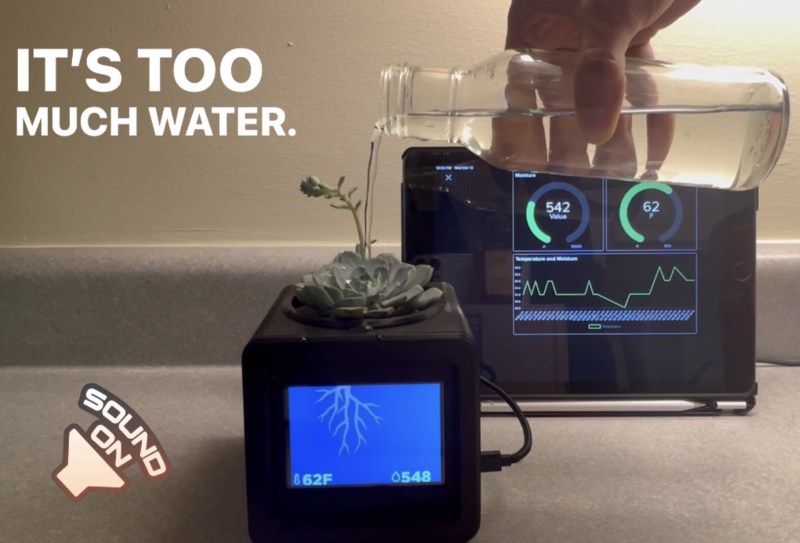For some reason, it seems like most of the plant monitoring setups we see separate the plant and the monitoring system. This makes sense in a don’t-own-a-waterbed-and-a-cat kind of way, but it also doesn’t from an aestheitc standpoint. This build by [Jorge Enrique Gamboa Fuentes] sure does look nice and tidy as an all-in-one unit, and fortunately is built with obvious issues in mind. It tracks water level, soil moisture, and soil temperature with a single device — a STEMMA-connected soil sensor that does all the monitoring work.
This attractive beginner build is a Python-powered project that runs on a PyPortal Titano and has a speaker that anthropomorphizes the thing so it can berate you politely ask for water in English. But the real magic of this build is in the enclosure itself. Thankfully, it’s designed with a drip tray, but it also keeps the electronics out of the water, allowing just the tip of the sensor to get wet. You can view the vital signs directly on the device, or on a web dashboard whenever you’re away.
In the future, [Jorge] wants to experiment with GCP and Azure, connect more flower pots together, and add more sensors so that it is more autonomous. One of the major lessons learned was that you probably shouldn’t start with a succulent, because they need very little water and this will drag out your development time considerably unless you over-water it, which will kill it. Check it out after the break.
If [Jorge] wanted to go the easy route, they might stick this plant under an old Keurig that’s been converted to an automatic watering device.
Via adafruit
















And the base is a vase!
All your vase are belongs to us.
You have no chance. Make your time.
Ha ha ha !
wish it had like ultrasonics to actually display the real plant roots
Maybe it is possible to grow a plant in gelatin or some other transparent medium?
Gelatine doesn’t allow oxygen near the roots, so that won’t work.
You can grow waterplants in flowing (oxygenated) water, or cacti in open air, so long as the humidity is high enough. Or you could use vertical glass plates to support the roots. Just keep in mind that roots need a microbiome and that microbiome needs nutrients, water and oxygen and it doesn’t like UV radiation. So ideally the roots should be shielded from the light that reaches the green parts.
If you have an idea of which way you want to go I can recommend some common plants that will work and solutions to support a biome for the roots without soil :)
The cut-off bases from green onions and celery grow happily in an aerated general hydroponics 3 part nutrient solution. They want lots of light, though.
Please point me in that direction!
I would like to know more.
Thank you
This is pretty easy. The next time you buy a pack of celery, cut it 1-2 inches up from the base. Peel off a few stalk bits from the outer ring and throw them way. Put the remaining stem base into a small dish with about a half inch of water in a place where you see it every day. Keep the water level up, and usually these will grow into a new plant. Green onions work the same way, cut them an inch from the bottom, cover in water, and they’ll grow a new small stem in a few days.
When my little celery and onion regrows started looking sad (pale colored indicating no nutrients) I put them into my extremely low-budget hydroponics setup, and they grow much better in it than just water. That system consists of two net pots from an earlier aquaponics experiment, a plastic container that used to have dishwasher tabs in it, and an airstone and airpump from an old fishtank. For light I have a GE LED led32p38w grow light. It’s overkill and you can use a sunny window if you have one; I don’t. For nutrients I bought the three-pack General hydroponics Flora system. This was the only part I purchased for this project ($35) and at my current rate of consumption will last roughly a thousand years. :/
I put a couple of pictures here: http://www.clutteredlab.com/2021/10/tiny-hydroponics.html
I would love this if it also had an automatic watering system for each different plant that would be able to keep things right while away for a trip for 2-4 weeks. It’s a really interesting concept!